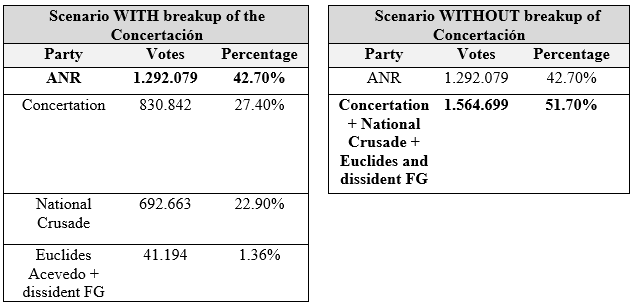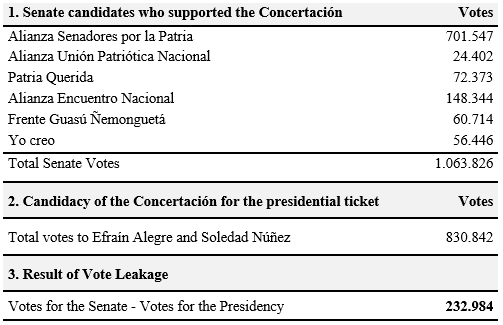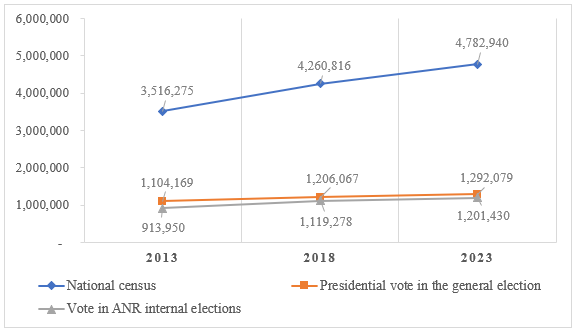
By Marcos Pérez Talia.
Last April 30, a new defeat of probably the most important opposition front formed to compete against the Colorado Party was consummated. The final difference, as huge as it was unexpected, makes all explanations seem valid. Here we seek to propose a couple of variables that shed light on the failure of the opposition in general and of the Concertación in particular.
The first reading that the results suggest is that the division of the opposition into, at least, two big formulas (Concertación and Payo Cubas) favored the new Colorado triumph. It is clear that in politics mere mathematics does not work, but it is also evident that with high opposition dispersion there is no chance of winning against the ANR.
The National Crusade party of Payo Cubas was the first to approve its entry to the Concertación and, in fact, signed the founding act on April 22, 2022. At that time, the one who offered the greatest resistance against the mechanism of selection of the presidential candidacy was Kattya González, and not even Cubas. But when the deadline to register presidential pre-candidatures was approaching, Payo Cubas raised his voice indicating that he wanted to team up with Efraín Alegre. As this finally did not happen, because Alegre and Soledad Núñez reached an agreement, Cubas opted to withdraw from the Concertación. The same happened with Euclides Acevedo and part of the Frente Guasú, who also decided to withdraw even when internal elections with a national electoral roll were approved, as they requested. Table 1 shows the possible scenarios, to illustrate the electoral size of the political forces inside and outside the Concertación.
Table 1. Main results with and without the split of the Concertación

Source: https://resultados.tsje.gov.py/publicacion/divulgacion.html
With Monday’s paper intriguing questions arise: why did Payo withdraw from the Concertación, having had that flow of votes he had on April 30? If he really wanted the opposition to triumph in 2023, why did he not compete internally as Sebastián Villarejo or Martín Burt did, or at least keep his word of unity as Esperanza Martínez did? Furthermore, Efrain and Soledad triumphed in the Concertación’s internal elections with 348,873 votes, and four months later Payo Cubas obtained 692,663 votes, almost twice as many votes as Efrain and Soledad. Cubas’ decision to withdraw from the Concertación is curious to say the least.
The change of speech is also striking. In June 2022, when Payo justified his absence at the signing of the Concertación agreement, he pointed out that “this trip to Argentina was already planned 15 days ago”, stressing that “from the first moment he agreed with the Concertación and that the president of Cruzada Nacional was present at the signing of the agreement”. Two months later, in a U-turn, Yolanda Paredes indicated that they were withdrawing from the Concertación “which is undermined by corrupt members and delinquents”.
Anyone could be confused by the wide recognition given to his candidacy by the Horacio Cartes’ media group. Or, even, the acknowledgement made by the General Representative of the ANR when he pointed out that Payo Cubas “grows in what we gave him the opportunity to grow…he grew because we wanted him to”. But that is another debate.
Regarding the Concertación, the Atlas Intel international poll possibly affected it negatively in the strategy of the last month and a half (see Graph 1 with the data of the published polls). Paraguayan polls were absolutely discredited after the 2018 embarrassment. However, Atlas Intel was coming in with a significant regional reputation after its work in Chile, Colombia, Argentina and Brazil. If it did so well in the regional forecast, why challenge its numbers?
Graph 1. Evolution of the main candidates in the three Atlas Intel surveys.
 Source: https://www.atlasintel.org/
Source: https://www.atlasintel.org/
The prediction regarding Payo Cubas was accurate; however, that of the ANR and Concertación was not. The Colorados finally obtained 10 points more than the last poll, and the Concertación 5 points less. If one of the purposes of a poll is to provide information for the parties and candidates to make strategic decisions (for example, to make a pact or not with Payo a month before the elections), clearly the Concertación was sailing in the blind. Such was the impact of the Atlas Intel survey that the international media echoed its figures and some of them even ventured to suggest that an alternation was possible.
There were also some problematic fronts with which the Concertación had to deal. First, Frente Guasú and Patria Querida were not fully cohesive in their support for the Alegre-Núñez duo. Second, Kattya González remained until the end in her dialectic dispute against the PLRA, not participating in any campaign event of the presidential ticket. And third, the stroke that Fernando Lugo had in August 2022, which not only affected the Frente Guasú electorally, but also deprived the Concertación of a leadership with strong links with the most disadvantaged. Lugo’s absence coincided with the loss with respect to 2018 of almost 220,000 votes for the Frente Guasú’s Senate list (and five fewer senators), while, coincidentally, Cruzada Nacional reaped around 270,000 more votes than in 2018 (and four more senators).
These problematic fronts of the Concertación (especially the lack of cohesion of its members) perhaps explain Table 2. An important leak of votes that the presidential formula had in contrast with the votes for the Senate that the candidates supporting the Concertación received.
Table 2. Potential leakage of votes by difference between the Senate and the Concertación’s Presidential Duo

Source: https://resultados.tsje.gov.py/publicacion/divulgacion.html
Without this leakage of votes, the result would have been closer to the ANR (1,292,079 versus 1,063,826), and Payo would have had a lower percentage. The explanations could be more abundant. In any case, the ANR continues to lead by its hard vote, which works, if you will, in an inertial way. The Colorado votes between 2018 and 2023 did not increase practically at all, even though the national electoral roll did.
The first reading that the results suggest is that the division of the opposition into, at least, two big formulas (Concertación and Payo Cubas) favored the new Colorado triumph. It is clear that in politics mere mathematics does not work, but it is also evident that with high opposition dispersion there is no chance of winning against the ANR.
Graph 2. Comparison of the ANR presidential vote vs. the ANR internal vote and the national electoral roll (2013 to 2023)

Source: own based on TSJE and ANR data.
In the last five years, the ANR grew by only 82,012 more votes, although in percentage terms that meant a decrease, from the 46.4% obtained by Mario Abdo in 2018, to 42.7% obtained by Santiago Peña in 2023. But it was enough for him again. And although it is true that they lost 4 percentage points, the cohesion and the Colorado hard vote remains unscathed, at least since 2013, something that does not happen in the other spaces. That surely explains the appeal to the merely intra-party vote with Peña vindicating dictator Stroessner or proposing to Coloradize the civil service. This agenda that has been repeated since Cartes might seem anachronistic, if you will, to a non-Colorado. But it clearly works for them.
In any case, the ANR was not a formula for change, even if one would like to insinuate the contrary. One thing is the powerful internal Colorado dynamics, in which two factions dispute power and alternate governments. But another is to say that the ANR was also a change, a change of what? From Nicanor to Cartes there were, yes, changes of ideas and men; from Cartes to this part, pure continuities. Not only are they practically the same people, but also the same government program. But, once again, that is another debate. Although it is good to clarify to prevent the unwary.
As long as the oppositions -in plural- continue prioritizing the individual agenda, there is Coloradismo for a while. Moreover, the “Blame Game” is futile in this instance. We must look at this failure as a learning exercise for the future. Another issue is the alleged fraud, whose protests led to the imprisonment of Payo Cubas, although we will have time to discuss it.
Cover image: Social Networks of Efrain Alegre.
